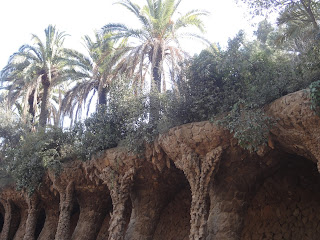Parc Guell is within walking distance of my art residency apartment. Happily, there are escalators to get there, six of them, each separated by a street. When you get there, you have more stairs and more climbing. I opted to go to the top most part first with its glorious views of the city. I then wended my way down to the official entrance I remembered from my first time in Barcelona in April, 1998. I'd then returned to Spain for a second time for a repeat residency at Fundacion Valparaiso and ended my stay, as with this time, in Barcelona and visiting friend Eva Eckhardt from Koln at her house on the island of Fomentara, which is off the coast of Ibiza. I'll fly to Ibiza on March 29, take the ferry to Fomentara and stay with Eva in the solar house she built in the 1970's with her then young son.
Today's post is about Parc Guell where there are many pigeons, squawking parakeets, and people from many countries. They join in the varied landscape, mosaic benches, rough and smooth columns (so reminiscent of Mexico's Uzmal and Chitzen Itza and Spain's conquistador days. The park therefore is a hugely creative example of the cross pollination of cultures.
Foreigners smiled at me. The Spanish Catalans appear to keep more to their inner lives. Young men often prance with an almost mock male walk. Open displays of affection abound between the sexes. Languages mix in the background. There's the English English, American English (just a smattering), Japanese, German. Of course Catalan is prime in this fiercely Barcelona space. I've noted that many foreigners live here, as exampled by my residency host Carla who is Swedish, and whose Jose (could be said to look somewhat Moorish) is from the USA.
The park is rough and smooth. Some sections are dirt grounded with rocky side walls. Then there are the columns of which some are seemingly rough hewn while also beautifully and rhythmically patterned. They speak of the power of the earth. Others further down the hill (or is it a mountain, being as it so steep?), have smooth tiles, others, the tallest are even fluted. Mosaics add a huge flourish, giving color and pattern to the display. They undulate on the benches around the large plaza that's reminiscent of the bull ring. Descending further, I discover the familiar (from my last visit) mosaic sculpture of the dragon beast and fountain. It's definitely derived from Meso-America. People hover around it to have their pictures taken and someone offered to take mine too.
The atmosphere is festive in this Gaudi land. His lush works gave us the English word gaudy, but he has survived the moniker, growing ever more popular and now being a source of popular and scholarly reverence. What once may have seemed disorderly has now become an orderly, exciting, diverse procession of the rough and the smooth, perfectly organized to be a source of welcoming delight for people of all ages and backgrounds. His achievements appear to be timeless. In closing, I salute his wise benefactors, the families Guell and Segrada fostered Gaudi's considerable output.
And now some pics:
Today's post is about Parc Guell where there are many pigeons, squawking parakeets, and people from many countries. They join in the varied landscape, mosaic benches, rough and smooth columns (so reminiscent of Mexico's Uzmal and Chitzen Itza and Spain's conquistador days. The park therefore is a hugely creative example of the cross pollination of cultures.
Foreigners smiled at me. The Spanish Catalans appear to keep more to their inner lives. Young men often prance with an almost mock male walk. Open displays of affection abound between the sexes. Languages mix in the background. There's the English English, American English (just a smattering), Japanese, German. Of course Catalan is prime in this fiercely Barcelona space. I've noted that many foreigners live here, as exampled by my residency host Carla who is Swedish, and whose Jose (could be said to look somewhat Moorish) is from the USA.
The park is rough and smooth. Some sections are dirt grounded with rocky side walls. Then there are the columns of which some are seemingly rough hewn while also beautifully and rhythmically patterned. They speak of the power of the earth. Others further down the hill (or is it a mountain, being as it so steep?), have smooth tiles, others, the tallest are even fluted. Mosaics add a huge flourish, giving color and pattern to the display. They undulate on the benches around the large plaza that's reminiscent of the bull ring. Descending further, I discover the familiar (from my last visit) mosaic sculpture of the dragon beast and fountain. It's definitely derived from Meso-America. People hover around it to have their pictures taken and someone offered to take mine too.
The atmosphere is festive in this Gaudi land. His lush works gave us the English word gaudy, but he has survived the moniker, growing ever more popular and now being a source of popular and scholarly reverence. What once may have seemed disorderly has now become an orderly, exciting, diverse procession of the rough and the smooth, perfectly organized to be a source of welcoming delight for people of all ages and backgrounds. His achievements appear to be timeless. In closing, I salute his wise benefactors, the families Guell and Segrada fostered Gaudi's considerable output.
And now some pics:



























Dear Friends and Allies,
ReplyDeleteI hope you enjoy this blog post. By writing this for you, I feel you are my companions on this art-making journey.